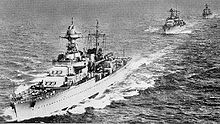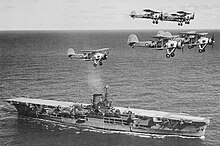Battle of Dakar
| date | September 24, 1940 |
|---|---|
| place | Dakar in Senegal |
| output | Vichy troops victory |
| consequences | French West Africa remains true to Vichy |
| Parties to the conflict | |
|---|---|
| Commander | |
| Troop strength | |
| 2 battleships, 1 aircraft carrier, |
1 battleship, 2 cruisers, |
| losses | |
|
2 battleships damaged, |
1 destroyer sunk, |
The battle of Dakar , sometimes referred to as Operation Menace , was the unsuccessful attempt by the Allies in September 1940 to take control of the strategically important port of Dakar in French West Africa (now Senegal ).
prehistory
After the defeat of France, it was unclear how the fleet would behave. When the British attacked Mers-el-Kébir ( Operation Catapult ) on July 3, 1940, the French fleet was prevented from overflowing in the Mediterranean. The remaining units in the Atlantic feared a similar fate. At the beginning of the war, the French fleet had blocked the Italian fleet in the Mediterranean, giving Great Britain a free hand in the Atlantic.
After the armistice, the behavior of the individual colonies was also unclear. While Cameroon and French Equatorial Africa, with the exception of Gabon, converted to Free France, French North Africa , French West Africa , Syria and French Indochina remained under the control of Vichy France.

De Gaulle believed he could convince the French troops in Dakar to change sides. Dakar was a well-developed naval port and better equipped than the British Freetown , the only Allied port in the east-central Atlantic.
In order to bring about a decision, the Allies sent a force to Dakar, which consisted of the following, almost without exception British ships: the aircraft carrier ( HMS Ark Royal ), two battleships ( HMS Resolution and Barham ), five cruisers , ten destroyers and some troop carriers for 8,000 Man landing troops. The battle order was to request the French governor Boisson to surrender and otherwise to take the city.
Vichy France's naval forces in Dakar included the partially finished (95%) battleship Richelieu , one of the most advanced battleship designs of the era. The Richelieu left Brest on June 18, 1940, a few days before the Germans took it. Until Pétain came to power (July 10, 1940), the Richelieu operated jointly from Dakar with the British aircraft carrier HMS Hermes . After the defeat of France, the Hermes separated from the Richelieu , moved to the open sea off Dakar and formed the core of a new combat group with the Australian heavy cruiser HMAS Australia . The three French cruisers ( Gloire , Georges Leygues and Montcalm ) and three destroyers had gone to Dakar from Toulon . The Gloire was stopped by machine damage and ordered to Casablanca . The other French ships reached Dakar and united there with the Richelieu , some other small combat ships and three French submarines of the 1500-tonne type ( Bévéziers (Q 179) , Ajax (Q 148) and Persée (Q 154) ).
course
In the early morning hours of September 23, 1940, carrier aircraft of the British aircraft carriers dropped leaflets calling on the Dakar crew to surrender. Aircraft of the Armed Forces for a Free France (Forces fr. Libres) took off from the Ark Royal and landed at Dakar airport, but the crews were immediately arrested. At the same time, marines of the Forces françaises libres (De Gaulles) landed on a beach in Rufisque, southeast of Dakar. Fog and strong defensive fire from the defenders made this operation fail. De Gaulle ordered its demolition in order not to "shed blood from the French for the French".
The next two days were dominated by artillery duels. The Richelieu was hit by two 38.1 cm shells from the Barham , and it only returned fire sporadically after the rear of the two main turrets had been damaged by an operator error. British torpedo planes sank the Vichy submarines Persée and Ajax , damaged the destroyer L'Audacieux and killed over 100 civilians in downtown Dakar.
On the side of the Allies the following losses occurred: The Vichy-French submarine Bévéziers attacked the battleship Resolution with torpedoes off Dakar . A torpedo hit and caused a water ingress that caused the ship to heel 12 °. In addition, a fire broke out in the boiler room, causing the machinery to fail. The Resolution had to be towed by HMS Barham to Freetown and was not fully operational again until October 1941. The French coastal batteries damaged the Barham .
Results
The Vichy Armed Forces were loyal to their state and defended Dakar against their former allies. The resolution was so badly damaged that it had to be dragged to Cape Town. In a retaliatory strike on September 24 and 25, 1940, the Vichy Air Force bombed Gibraltar and sank an auxiliary cruiser in the port.
The Allies had to give up the idea that the French colonies would move more quickly to the camp of Free France. Charles de Gaulle's reputation with the British had suffered due to his misjudgment, and even the success in the Battle of Gabon in October 1940 restored his reputation with great difficulty.
Ships involved
Allies
- Aircraft carrier: HMS Ark Royal
- Battleships: HMS Barham , HMS Resolution
- Heavy cruisers: HMAS Australia , HMS Cumberland , Devonshire
- Light cruisers: HMS Dragon , HMS Delhi
- Destroyers: HMS Echo , HMS Eclipse , HMS Escapade , HMS Faulknor , HMS Foresight , HMS Forester , HMS Fortune , HMS Fury , HMS Greyhound , HMS Inglefield
- Escort ships: HMS Bridgewater , Commandant Dominé , Commandant Duboc , Houduce , HMS Milford , Savorgnan de Brazza en: Elan class minesweeping sloops
- Merchant ships: four Free French and one British
- Troop carriers: Westernland (Dutch passenger steamer), Pennland (Dutch passenger steamer), Sobieski (Polish passenger steamer) and three others
- 101st Royal Marine Brigade
- 13. Demi-brigade of the Légion étrangère
Vichy regime

- Battleship: Richelieu
- Light cruisers: Georges Leygues , Montcalm
- Destroyers: L'Audacieux , Le Fantasque , Le Malin , Le Hardi
- Escort ships: Calais , Commandant Rivière , D'Entrecasteaux , D'Iberville , Gazelle , La Surprise
- Auxiliary cruisers: El Djezair , El Kantara , El Mansour , Schœlcher , Ville d'Oran
- Merchant ships: Porthos , Tacoma Sally Maersk (Danish freighter)
- Submarines: Ajax , Béveziers , Persée
See also
Web links
- Private French site with a detailed description of the processes and the ships involved
- Dakar: Operation Menace ( Memento of August 13, 2014 in the Internet Archive )
- Royal Navy and World War 2: September 1940
- Book review: The Guns of Dakar and Operation Menace
- Photographs
References and comments
- ^ Lippman, David H., "Debacle at Dakar," WWII History , July 2011, pp. 48-55.
- ^ Churchill, Winston Spencer: The Second World War: the Finest Hour, Houghton Mifflin Company, Boston, 1949.
- ↑ Lindba︠e︡k, Lise: Norway's new saga of the sea: the story of her merchant marine in World War II . Exposition Press, 1969, p. 204.
Coordinates: 14 ° 40 ′ 43 " N , 17 ° 25 ′ 15" W.


